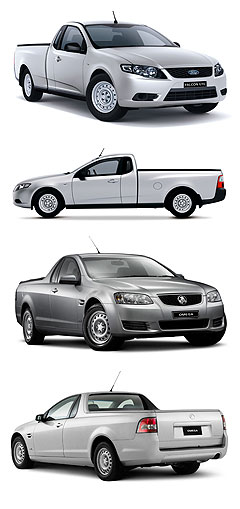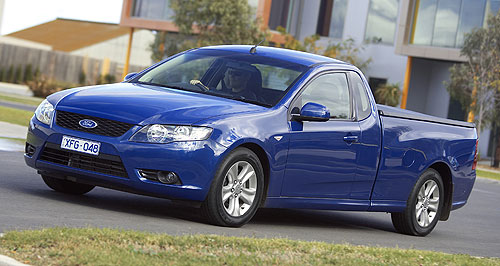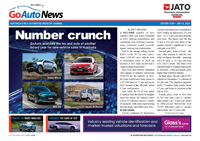Make / Model Search
News - General News - SalesImports dominate government sales’Lux a fortune: Federal agencies are not required to submit a business case for purchasing imported light commercials like the Toyota HiLux, despite a government policy of buying Australian-made unless not “operationally suitable”. All tiers of government favour imported cars including ‘buy Aussie’ federal agencies11 Sep 2012 By TERRY MARTIN FEDERAL government agencies are now buying more imported vehicles than locally built cars, despite a clear fleet vehicle selection policy that has ‘Made in Australia’ as its core tenet. State and territory government vehicle purchases outside the manufacturing bases of Victoria and South Australia are also heavily skewed towards imported vehicles, while local governments across the board favour cars built offshore. As overall sales of locally built vehicles continue to fall, threatening the viability of Australian car manufacturing, official figures obtained by GoAuto show that of the 2753 federal government new-vehicle registrations to the end of August this year, 52 per cent (1322) were imported vehicles, while over the same period last year the percentage was slightly higher at 56 per cent (2222 imports compared to 1751 local vehicles). Among the states, the government fleet preference for imported vehicles is much higher at 63 per cent so far this year, with 16,346 imports compared with just over 9500 locally built cars. Take Victoria and South Australia out of the equation, and Aussie-built cars make up only 26 per cent of state and territory government purchases.  From top: Locally built Ford Falcon Ute and Holden Ute. From top: Locally built Ford Falcon Ute and Holden Ute.For local government authorities, the percentage of locally built cars sold across the nation this year is even lower at just 19 per cent (1648 vehicles). The majority of this year’s federal government sales – be they local or imported – have been SUVs (1486), well ahead of passenger cars (at just 522) as well as light commercial vehicles (513) and heavy vehicles (232). In comparison, passenger cars dominate YTD state government purchases to the tune of 13,000 units, followed by LCVs and SUVs at around half that volume and heavy vehicles at the 1100 mark. Local governments, on the other hand, are favouring light commercials (3234) so far this year over passenger cars (2646) and SUVs (1919), with heavy vehicles further afield. For the federal agencies in particular, the high percentage of imports is surprising given the emphasis the Commonwealth government places on sales of Australian-made vehicles. Former industry minister Kim Carr routinely argued that public and private fleet sales underpinned the health of the local car industry, and urged that state governments follow the federal government’s ‘buy Australian’ lead. The trend also looks to be at odds with the ‘fleet vehicle selection policy’ published by the federal department of finance and deregulation. In selecting passenger cars within the Australian government fleet, the policy directive is that the vehicle “must be made in Australia and have a five-star ANCAP safety rating” (which all local models achieve). The policy then states: “Where no operationally suitable Australian-made passenger vehicle exists, agencies must provide a business case for the chief executive or their delegate’s approval detailing the operational requirements that precludes the selection of an Australian-made passenger vehicle.” The requirements are less stringent for LCVs, with the same Australian-made preference but only four ANCAP stars (both Holden’s and Ford’s local utilities score five stars) and no need for a fleet manager or other purchasing official to provide a business case when considering an imported vehicle. Asked to explain why federal agencies had purchased more imported vehicles this year than locally manufactured cars, given the ‘buy Australian’ rules, the federal finance department said in a written statement to GoAuto that the government clearly purchased a majority of Australian-built passenger cars. With only two local light commercials available, the department said “the situation is different” and that there were “many more cases where there are legitimate operational reasons that make an imported vehicle more appropriate” – hence the reason why a business case was not required and the likelihood of these models coming from offshore. “The Australian government selects a wide range of operationally suitable vehicles, from passenger vehicles through to light and heavy commercial vehicles,” the department said. “The majority of commercial vehicles are not manufactured in Australia, which would affect statistics. “The Gillard government actively supports Australian car manufacturers. Not only are the vast majority of passenger vehicles Australian-made, the proportion is increasing. “However, there are situations where the operational requirements of government agencies mean that they need to buy imported vehicles.” Federal figures show that the Commonwealth fleet size as at June 30 was 14,145 vehicles, with 54 per cent of these passenger cars and 34 per cent light commercials. From the entire fleet, 62 per cent were Australian-made and 27.9 per cent were imported by an Australian car-maker, leaving 10.1 per cent imported by a brand other than Toyota, Holden and Ford. State and territory governments clearly have different purchasing policies, with some, such as Queensland, placing more emphasis on vehicle emissions than Australian assembly. The Australasian Fleet Management Association’s research and communications director, Ken Thompson, told GoAuto that one of the reasons behind the rise of imported vehicle sales among government fleets was that the people purchasing them were now carefully considering the cost equation and relevance of a vehicle rather than simply its country of origin. “This is a theme that the association (AFMA) has been pushing for a long time – fleet managers are getting smarter and fleet management is getting recognised as more of a complex management discipline,” he said. “The starting base is to understand your transport needs and then to purchase vehicles that are, as we call, fit for purpose. So you’re matching the vehicle with your need rather than saying I like a Ford or a Holden or a Toyota. “Putting it a slightly different way, fleet managers and management are starting to manage the fleet rather than just acquiring vehicles.” Mr Thompson said the same also applies for the plug-in hybrid and electric vehicles, which bring environmental kudos but might not make sense from a fleet management perspective based on ‘whole-of-life’ cost. In overall terms, he said “you’re identifying your transport needs, looking for vehicles that are ‘fit for purpose’, and then of those vehicles that are fit for purpose you do a cost-benefit analysis and choose the vehicle that gives you the lowest whole-of-life cost”. Mr Thompson said an organisation should only then consider whether it made sense to pay a premium to purchase a more expensive ‘green’ car or locally manufactured vehicle that might be more expensive than an imported equivalent. equivalent.  Read more11th of September 2012  Market Insight: Government sales hurting car-makersGovernment sales fall 22.5 per cent in August as pain continues for local car-makers5th of September 2012  August VFACTS: Car sales on record paceAussies miss out as imports drive vehicle sales to new heights in August4th of May 2012  Market Insight: Rethinking the term ‘large’Local large cars still in spotlight as sales trough deepens and sector restructures12th of August 2011  Market Insight: Small cars in heavyweight boutHolden Cruze and Hyundai i30 go head to head in battle for fleet buyers |
Click to shareGeneral News articlesResearch General News Motor industry news |











Facebook Twitter Instagram